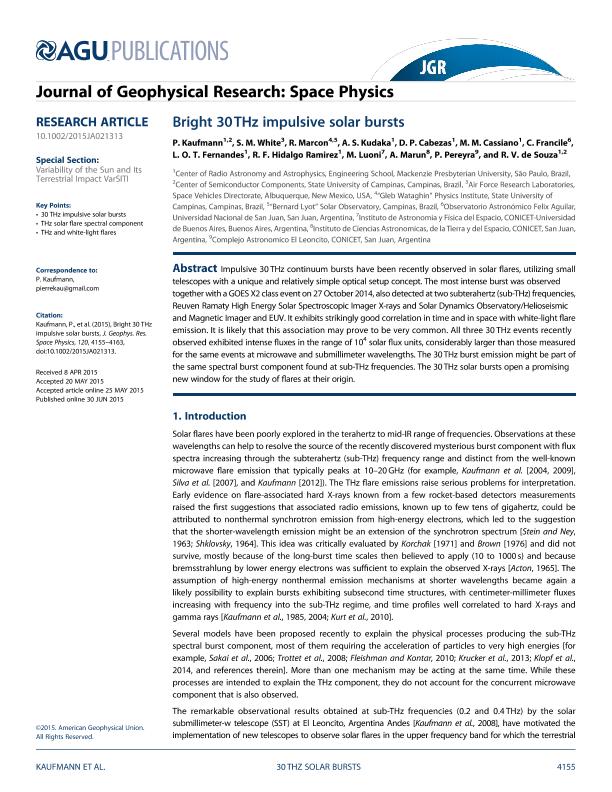Artículo
Bright 30THz impulsive solar bursts
Kaufmann, P.; White, S. M.; Marcon, R.; Kudaka, A. S.; Cabezas, D. P.; Cassiano, M. M.; Francile, Carlos Natale; Fernandes, L. O. T.; Hidalgo Ramirez, R. F.; Luoni, Maria Luisa ; Marun, Adolfo Hector
; Marun, Adolfo Hector ; Pereyra, Pablo Florencio
; Pereyra, Pablo Florencio ; De Souza, R. V.
; De Souza, R. V.
 ; Marun, Adolfo Hector
; Marun, Adolfo Hector ; Pereyra, Pablo Florencio
; Pereyra, Pablo Florencio ; De Souza, R. V.
; De Souza, R. V.
Fecha de publicación:
06/2015
Editorial:
Blackwell Publishing
Revista:
Journal of Geophysical Research: Space Physics
ISSN:
0148-0227
Idioma:
Inglés
Tipo de recurso:
Artículo publicado
Clasificación temática:
Resumen
Impulsive 30THz continuum bursts have been recently observed in solar flares, utilizing small telescopes with a unique and relatively simple optical setup concept. The most intense burst was observed together with a GOES X2 class event on 27 October 2014, also detected at two subterahertz (sub-THz) frequencies, Reuven Ramaty High Energy Solar Spectroscopic Imager X-rays and Solar Dynamics Observatory/Helioseismic and Magnetic Imager and EUV. It exhibits strikingly good correlation in time and in space with white-light flare emission. It is likely that this association may prove to be very common. All three 30THz events recently observed exhibited intense fluxes in the range of 104 solar flux units, considerably larger than those measured for the same events at microwave and submillimeter wavelengths. The 30THz burst emission might be part of the same spectral burst component found at sub-THz frequencies. The 30THz solar bursts open a promising new window for the study of flares at their origin. Key Points 30THz impulsive solar bursts THz solar flare spectral component THz and white-light flares
Palabras clave:
30thz Solar Bursts
,
Mid-Ir Solar Physics
,
Solar Flares
,
Thz Burst Emission
Archivos asociados
Licencia
Identificadores
Colecciones
Articulos(CASLEO)
Articulos de COMPLEJO ASTRONOMICO "EL LEONCITO"
Articulos de COMPLEJO ASTRONOMICO "EL LEONCITO"
Citación
Kaufmann, P.; White, S. M.; Marcon, R.; Kudaka, A. S.; Cabezas, D. P.; et al.; Bright 30THz impulsive solar bursts; Blackwell Publishing; Journal of Geophysical Research: Space Physics; 120; 6; 6-2015; 4155-4163
Compartir
Altmétricas



